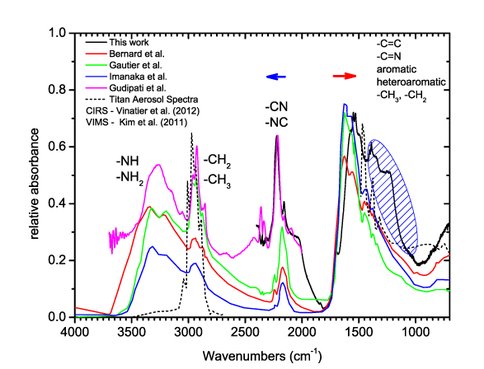2014 Annual Science Report
 NASA Jet Propulsion Laboratory - Titan
Reporting | SEP 2013 – DEC 2014
NASA Jet Propulsion Laboratory - Titan
Reporting | SEP 2013 – DEC 2014
Longer Wavelength Photochemistry of Condensates and Aerosols in Titan’s Lower Atmosphere and on the Surface
Project Summary
This study focuses on the condensed phase photochemistry on Titan. In particular, we focus on understanding longer wavelength photochemistry of solid hydrocarbons so simulate photochemistry that could occur based on the UV penetration through the atmosphere and on the evolution of complex organic species in astrobiologically significant regions on Titan’s surface. Here we investigate the oxygenation chemistry involving the condensed Titan’s organic aerosols with water-ice on Titan’s surface – induced by high energy photons simulating the cosmic ray induced chemistry on Titan’s surface.
Project Progress
The majority of our laboratory work was focused during the Summer June – August 2014, during which one joint PhD student (Benjamin Fleury) and one masters student (Laura Selliez) from the collaborator Prof. Nathalie Carrasco’s group worked with Murthy Gudipati in conducting the experimental work. The focus of this work is to determine whether photons at longer wavelength could induce chemical reactions involving one of the most abundant unsaturated molecules in Titan’s atmosphere: acetylene when accreted on to laboratory generated “tholins and organic polymers” – analogs of Titan’s aerosols and surface organics. We were successful and observed consistently that acetylene is depleted during photolysis only when adsorbed on tholins. One publication for a high-impact journal is in preparation, involving Bob West and the Cassini team and two French teams.
During March-April 2014 Murthy Gudipati took various tholin samples, including the photopolymer from dicyano acetylene (C4N2) — which was the focus of our Nature Communications Paper in 2013 — to Grenoble to Veronique Vuitton’s lab to conduct their mass spectroscopic analysis. The results from these “orbitrap” mass spectrometry are very exciting. We could clearly see dimers, trimers of C4N2, further evidence for longer-wavelength induced photopolymerization in condensed Titan’s molecular ices. One publication is in preparation.
Publications
-
Couturier-Tamburelli, I., Gudipati, M. S., Lignell, A., Jacovi, R., & Piétri, N. (2014). Spectroscopic studies of non-volatile residue formed by photochemistry of solid C4N2: A model of condensed aerosol formation on Titan. Icarus, 234, 81–90. doi:10.1016/j.icarus.2014.02.016
-
Lavvas, P., West, R. A., Gronoff, G., & Rannou, P. (2014). Titan’s emission processes during eclipse. Icarus, 241, 397–408. doi:10.1016/j.icarus.2014.07.008
-
PROJECT INVESTIGATORS:
-
PROJECT MEMBERS:
Murthy Gudipati
Project Investigator
Nathalie Carrasco
Collaborator
Isabelle Couturier
Collaborator
Benjamin Fleury
Collaborator
Véronique Vuitton
Collaborator
Robert West
Collaborator
-
RELATED OBJECTIVES:
Objective 1.1
Formation and evolution of habitable planets.
Objective 2.2
Outer Solar System exploration
Objective 3.1
Sources of prebiotic materials and catalysts
Objective 3.2
Origins and evolution of functional biomolecules
Objective 3.3
Origins of energy transduction
